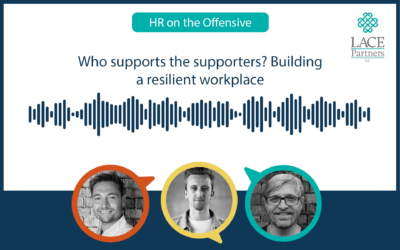A key challenge for HR teams and Chief People Officers (CPOs) is the digital employee experience (EX). But does HR even own it? And how best can the digital EX be monitored and managed?
Along with new partners Actual Experience, Dave Page and Cathy Acratopulo, explored some of these themes in our recent podcast. Then, in March we gathered a collective of CPOs together to look at some of the challenges faced in the digital EX space. We’ve picked out some of the topics of conversation from the dinner and in today’s blog we reflect on some of the debates that were had. If you are a CPO/CHRO and you want to be part of our growing community who regularly meet up to discuss the latest critical thinking and challenges they are facing, there is a form at the bottom of the page for you to reach out to us to register your interest.
Who owns the digital employee experience?
While employee experience has been at the heart of HR delivery for years, of course, the increase in attention of delivering exceptional digital employee experience – particularly post pandemic and in the hybrid working world – has presented well-documented new barriers for CPOs to overcome (just see our ‘one big thing’ campaign and the discussions we’ve highlighted around hybrid working as an example). And now we’re firmly in the new-look post-pandemic working environment, HR leaders are reassessing the ways in which their organisations are delivering this.
Assessing and managing the digital employee experience is complicated by a lack of clarity over ownership and it was this discussion which formed a consistent thread of discussion throughout our latest CPO forum. When we spoke to our community of CPOs one of the biggest debates surrounded this fundamental question: Should it be the CPO, the Chief Information Officer (CIO) or Chief Technology Officer (CTO) who has overarching responsibility?
That question is not easily answered, but there is a significant difference between the way each of these positions view digital employee experience, by the very nature of the accountability and focus they have within their organisation. For example, a CPO will always want to focus on the ease with which employees will be able to interact with the technology that they have, while CIOs and CTOs focus more on the technology itself; it’s usage, the value of it, the challenges on technical implementation, etc.
Either way, the way in which employees interact with their work is heavily dependent on a good digital EX. One of the big discussions from the group included how organisations effectively gather data in order to assess the buy-in to delivering on a good digital EX. In fact, how best to track digital EX and how employees are feeling about it, is one of the most fundamental challenges facing CPOs and HR right now, based on the conversations from our forum.
Tracking and managing digital EX
Forum attendees talked engagement and monitoring, with many measuring this through employee engagement and pulse surveys. Others use tools such as CultureAmp were cited and there was general recognition that anecdotal feedback is just as important as these methods. But has anybody truly ‘cracked it’? The jury is still out. Not least because of the responsibility of who owns those processes; and as the CPOs elaborated on, responsibility doesn’t always sit with the HR function. The department in control of canvassing employees and getting honest feedback was a contentious debate, with one CPO recounting that tracking digital EX has been perceived in a negative light by other business units; questions over how the data is used and by why being amongst just one of the examples listed. To mitigate this, the trick was to garner cross-functional business unit buy-in. Working with stakeholders in data gathering and management is, therefore, important (something that we’ve highlighted in our recent whitepaper on people and workforce analytics).
Other businesses are coming up against different challenges when it comes to digital EX management. For example, for some organisations it’s the Communications Team in charge of monitoring and gathering data on digital experience. Why? Especially when filtering the experience through a media and comms lens rather than the lived experience of employees is not necessarily the best use of the data. The question remains – which was a central premise of the debate on the night – why doesn’t the CPO have overall accountability of the digital employee experience? It is not the sole preserve of HR to deliver on great digital employee experience (see below re: collective responsibility), but surely the CPO should have the overarching remit for accountability?
There is a clear opportunity here for CPOs: lead the strategic discussion around digital employee experience by leveraging data with fellow C-Suite members because, if you aren’t leading that debate and leveraging tools available on the market, the threat is that the CIO/CTO will drive the agenda and look to take the responsibility for EX.
Gaining employee trust
Discussion picked up on the fact that some businesses have trade union relationships firmly embedded in their working practices. Where an employee has trust that the union is looking out for the best interests of the individual, it would stand to reason that they have more information and data on what employees really think than the business itself does.
Many employees are simply more willing to open up to their union more than their employer. And that’s down to trust – they don’t trust how their employer will use their data.
Data analysis and leaver trends
This led on to a more detailed debate regarding employee data management and, crucially, analysis. Some attendees mooted the idea of utilising information gleaned from exit surveys (and other standard mechanisms and data points such as absenteeism) to predict patterns associated with potential leaver. The aim with all data analysis is to minimise the likelihood of employees reaching a disciplinary/complaint case stage in their career journey.
Some organisations are already measuring temperament using biometric data points to determine when an employee is edging towards leaving, although this is not common, as the team from Actual Experience noted on the night. The consensus was that HR needs to be more proactive about embracing this data analytical evolution and only when HR can embrace some of these technological advances, will we see the true power of leveraging data to demonstrate increased productivity in the workforce.
The use of AI and automation in data analysis will allow HR to go far beyond the basics of data capture. There is an urgent need for the HR function to rapidly assimilate new ways of interpreting, analysing and understanding data and whilst many organisations don’t appear to be fully embracing AI and its function to automate tasks, the space is rapidly evolving as the big tech firms begin to invest more and more in improving AI and its usage.
Regaining the narrative
The digital employee experience is an incredibly valuable tool for improving productivity and strategising for the future. This is the real story of the digital EX, which CPOs and HR teams feel is getting lost.
An improved digital EX allows for sophisticated data tracking and analysis that can and should be used to inform overall business strategy is key, but the data has to be meaningful and has to be interpreted and analysed intelligently.
Data in and of itself has little meaning. Without sophisticated analysis and a deep understanding of what it can be used to achieve, data gathering is largely redundant. It’s time for HR functions to challenge themselves on the data they collect, its meaning and what it is being used for.
All employee sentiment data – whether that’s gathered from exit interviews or other data points – needs to be funnelled back into improving the digital EX.
Collective ownership of the digital EX
We touched earlier on the complexities involved in owning and managing the digital employee experience. And while ultimately the ownership stops with the CEO and their ultimate accountability, there needs to be a shift towards cross-functional ownership within a business.
A truly useful digital EX must be collectively owned as there are so many elements necessary to create a coherent system. For example, an employee’s line manager plays an integral part in ensuring that their lived experience is worthwhile. Alongside the work of the line manager, the tools need to put in place by HR, the CPO’s team, IT and the CIO’s team.
However, the line manager’s role is more significant and visible to the employee. Without the proper support and coaching to utilise the technology available to the employee, much will be lost. This, all too often, can leave the employee feeling dissatisfied and more likely to leave.
The goal should always be to have a single, unified digital EX across the entire organisation, rather than separate systems across different business units.
So, what should you do next? Challenge yourselves to map your employees’ touch points, work out where the influence lies, then begin to refine your approach to digital employee experience. IF you need some help, we are of course here to support.
Join us at the next forum
If you’d like to discuss any of the points raised from the CPO forum, or you are a CPO/CHRO and would like to take part in the next, fill in the form below and we’d be happy to chat.






